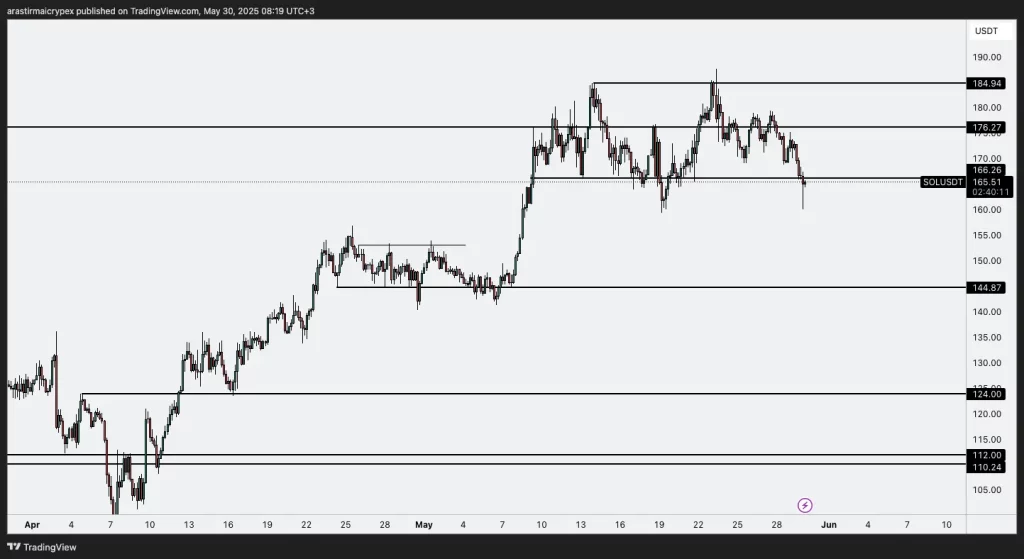Trump’s Tariffs Will Remain in Force – SEC Says Proof-of-Stake Staking Transactions Aren’t Considered Securities
Trump’s Tariffs Will Stay in Place
The U.S. Court of Appeals for the Federal Circuit has temporarily reinstated the Trump administration’s sweeping tariffs. The decision comes after the U.S. Court of International Trade ruled a day earlier that Trump had overstepped his authority and struck down the tariffs. The court has given plaintiffs until June 5 and the government until June 9 to respond.
Trump’s “Independence Day Tariffs,” as he calls them, are based on additional tariffs on imports from most trading partners, as well as on countries like China, Canada and Mexico. The lower court ruled the move unconstitutional, but the appeals process remains uncertain. Trump has called the decision a “national threat,” while some allies have interpreted it cautiously. The tariffs will remain in effect at around 15% while the appeals process continues.
SEC Says Proof-of-Stake Staking Transactions Not Considered Securities
The Division of Corporate Finance of the U.S. Securities and Exchange Commission (SEC) has announced that staking activities conducted on proof-of-stake (PoS) networks do not qualify as securities transactions. With this decision, staking users and “staking service providers” are no longer required to register with the SEC.
The clarification covers a variety of scenarios, including individual staking, self-custodial staking through third parties, and staking conducted by custodians on behalf of their clients. Rebecca Rettig, chief legal officer at Jito Labs, said the decision paves the way for crypto ETFs to integrate staking. However, SEC Commissioner Caroline Crenshaw criticized this approach, saying it did not adequately consider investor risks.
SEC Drops Binance Case
The U.S. Securities and Exchange Commission (SEC) filed a joint application on Thursday to drop the Binance case it filed in June 2023. The drop is considered part of the SEC’s shift in crypto policy after the Trump administration. In the filing, the SEC stated that it wanted to end the litigation process as a “political decision” and requested that the case be closed “definitively” so that it could not be reopened.
Binance.US welcomed the decision, arguing that this development showed that the accusations against the company were baseless. The SEC had dropped many crypto cases, not just Binance, since Trump took office. The move backs down to a regulatory reshaping under the leadership of newly appointed SEC Chairman Paul Atkins.
Ripple’s Hidden Road Launches OTC Crypto Swap Service in the US
Hidden Road, which Ripple acquired last month for $1.25 billion, has launched a cash-settled OTC crypto swap service aimed at institutional investors in the US. The new product is offered through Hidden Road’s FCA-regulated UK-based arm and covers major crypto assets such as Bitcoin and Ethereum.
OTC swaps allow large-volume transactions to be conducted directly between two parties without affecting exchange prices. Hidden Road CEO Michael Higgins noted that these products are largely unavailable to institutional investors in the US. This launch is one of the first major products Ripple has launched since acquiring Hidden Road. Hidden Road is also known as one of the first companies to receive a MiCA license in Europe.
SEC Postpones Grayscale’s Avalanche and Cardano ETF Decision to July
The U.S. Securities and Exchange Commission (SEC) has postponed its decision on Grayscale’s Avalanche and Cardano spot ETF applications to July 15, 2025. The SEC announced that this decision was made in order to “more comprehensively evaluate the proposed rule change.” The postponement shows that the SEC continues its cautious approach to crypto-based ETFs.
The Avalanche ETF application was made through Nasdaq, while the Cardano ETF application was made through NYSE Arca. So far, no altcoin ETF other than Bitcoin and Ethereum has received approval. It is known that the SEC has similarly extended the decision periods for many ETF applications, including Solana, XRP and staking-focused products. The delays are a routine procedure the SEC follows when evaluating new financial products, analysts say.
Cantor Launches Gold-Hedged Bitcoin Fund
Cantor Fitzgerald announced the launch of a new fund that will offer direct investment in Bitcoin, providing one-to-one protection against price declines with gold. The five-year fund will provide investors with a “1-to-1” hedge against declines in Bitcoin while benefiting from Bitcoin’s upside potential. The fund is expected to begin accepting investments soon.
Cantor’s first Bitcoin-focused fund reflects its recent interest in digital assets. The firm also launched bitcoin-backed loans with Maple Finance and FalconX this week. The 79-year-old company is currently reported to be managing $14.8 billion in assets, while it was recently reported that it was planning a $3 billion Bitcoin project with SoftBank, Tether and Bitfinex.
Central Bank of Russia Opens Crypto Derivatives to Qualified Investors
The Central Bank of Russia has approved the offering of crypto-related derivative products that are only accessible to qualified investors. However, these products are required to be non-deliverable, meaning investors cannot directly own assets such as Bitcoin or Ethereum. The bank emphasized that these derivatives should be offered with full capital and that an individual investment limit should be applied.
This step shows Russia’s cautious but flexible approach to crypto. Isolated from the global financial system due to sanctions imposed after the invasion of Ukraine in 2022, Russia had begun to evaluate crypto as a liquidity protection and international payment tool. In recent months, crypto mining has been legalized, a government-backed crypto platform has been planned, and a three-year trial period has been offered exclusively to ultra-rich investors.
SOL Strategies Prepares $1 Billion Flexible Funding Plan for Solana Investments
SOL Strategies, a Canadian firm focused on Solana, has filed a $1 billion preliminary shelf prospectus, which allows the company to quickly issue stock, debt, and similar securities in the future. While the company does not currently have any new issuance plans, the move will allow it to immediately respond to opportunities in the Solana ecosystem.
CEO Leah Wald said the prospectus supports the company’s growth strategy and provides the ability to respond quickly to evolving Solana opportunities. SOL Strategies, which provided capital for the Solana acquisition with a $500 million convertible note in April, aims to support the development of decentralized applications and services on Solana.
DeFi Development Grows Solana Assets with Liquid Staking
Nasdaq-listed DeFi Development Corp. has begun managing Solana assets with liquid staking token (LST) technology. The company announced that it has converted a portion of its 609,190 SOL holdings into an LST called dfdvSOL, built on the Sanctum infrastructure. The move makes the company the first public company to own LST on Solana.
DeFi Development had shifted to a new strategy focused on Solana in April after former Kraken executives acquired a majority stake. The company also raised $24 million in private equity earlier this month. The stock price fell 16.95% to $22.19 following the latest statements, while the current market value of total SOL assets is approximately $105.8 million.
———————————————————————————————
BITCOIN(BTC)
BTCUSDT has broken down both its horizontal support and the rising trend line after the sales from the 111.861 region. This situation indicates that the rise is weakening structurally and a correction process has begun in the short term. The levels of 105.778 and 101.315 should be monitored as the next support areas. In upward recoveries, the first resistance will now be 107.319 and then the broken trend line. If the decline below the trend line is permanent, 94.915 support may come to the fore again.
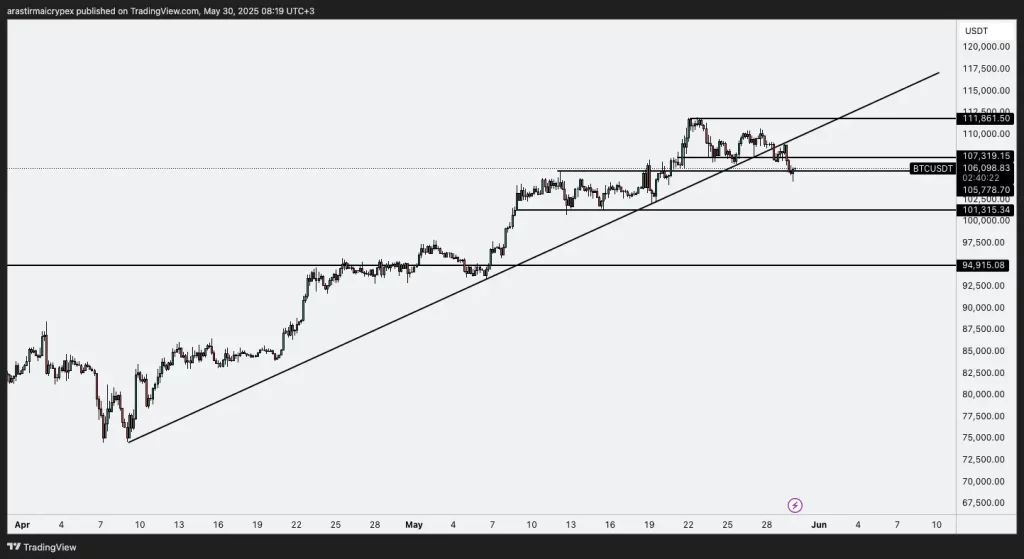
ETHEREUM(ETH)
ETHUSDT continues to maintain a horizontal consolidation structure in the $ 2,500 – $ 2,700 band. The price is stuck within this band and volatility seems to have decreased gradually. Closes above 2,700 should be sought for an upward break. In this case, the 2,857 resistance may become the target. In the downward pressure, closing below 2,500 may initiate a selling wave in which the price may fall to 2,097 again.
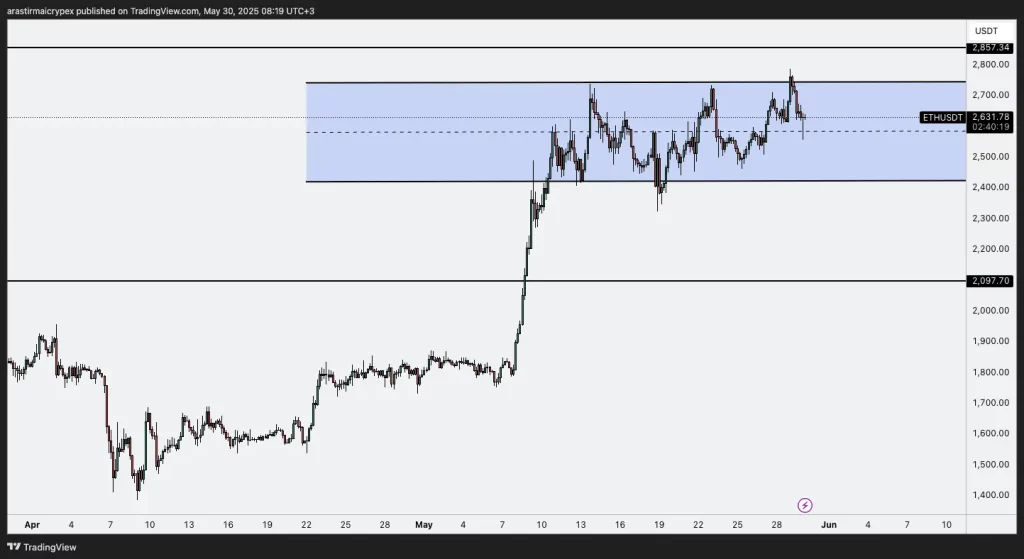
RIPPLE(XRP)
On the XRPUSDT side, the price broke down the horizontal support at 2.2330 and entered the demand area shown in the green zone. This region was a region where buyers were active in the past and for now, the first reaction seems to have been received from here. However, in terms of the general structure, low bottom and low top formations indicate selling pressure. If permanence is achieved below 2.1139, a new downward movement towards the level of 1.9223 can be observed. In possible recoveries, 2.2330 will become resistance again.
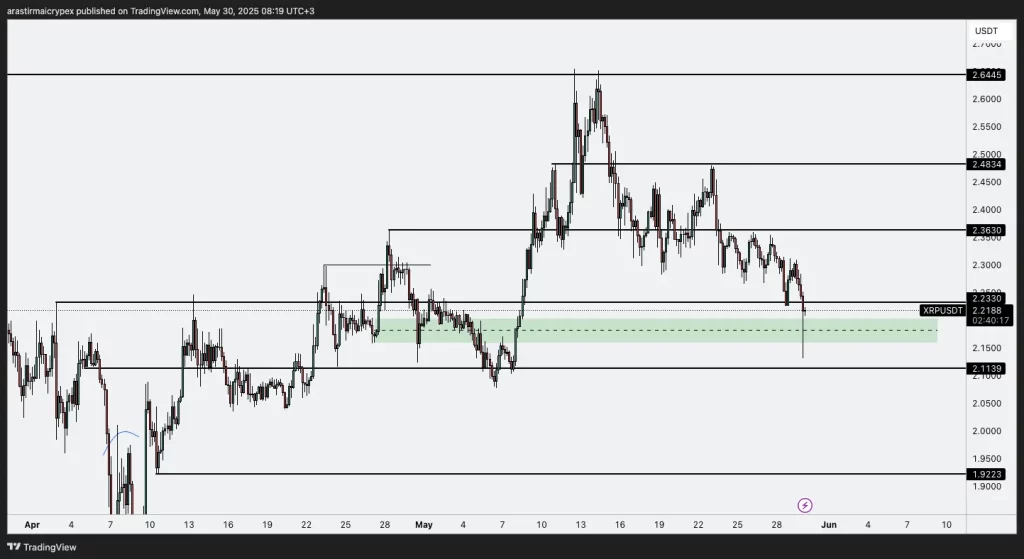
AVALANCHE(AVAX)
On the AVAXUSDT chart, the price has broken down the 22.09 support with the sales coming from the resistance at 23.46. This area was previously an important support that received reaction purchases. The current price action indicates that the 21.03 level will be tested. If this support is also broken downward, the short-term downtrend for AVAX will be confirmed. Above, the 22.09 level should now be watched as a resistance.
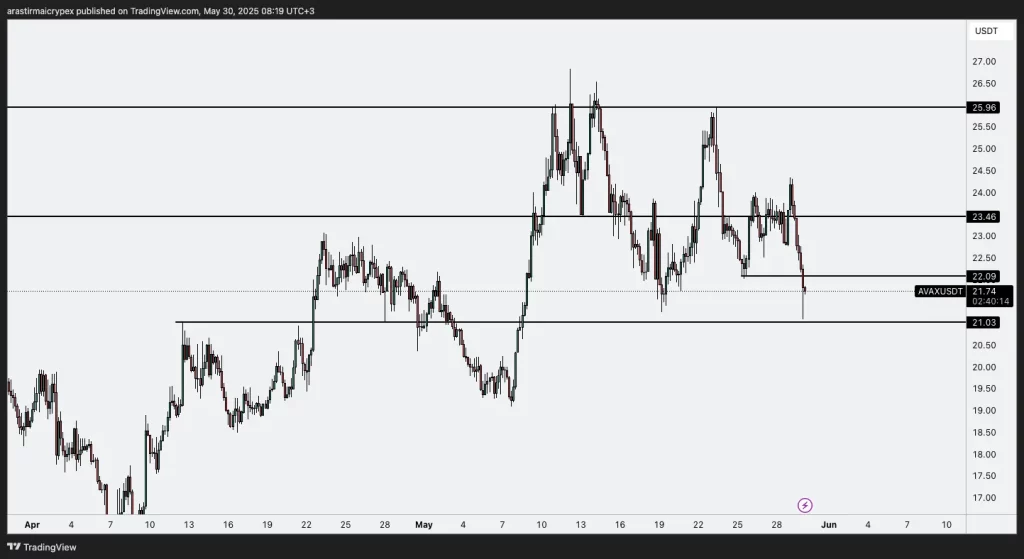
SOLANA(SOL)
SOLUSDT price, after receiving a sharp rejection from the strong resistance area at 176.27, broke downwards and fell to the 165.50 support. This area had also worked as one of the bottoms of the short-term structure, and the fact that the price could not hold at this level shows that the selling pressure is deepening. Daily closings below 165.50 may carry the price to the 144.87 and 124.00 supports, respectively. For an upward recovery, it is necessary to maintain stability above the 176.27 level again.
